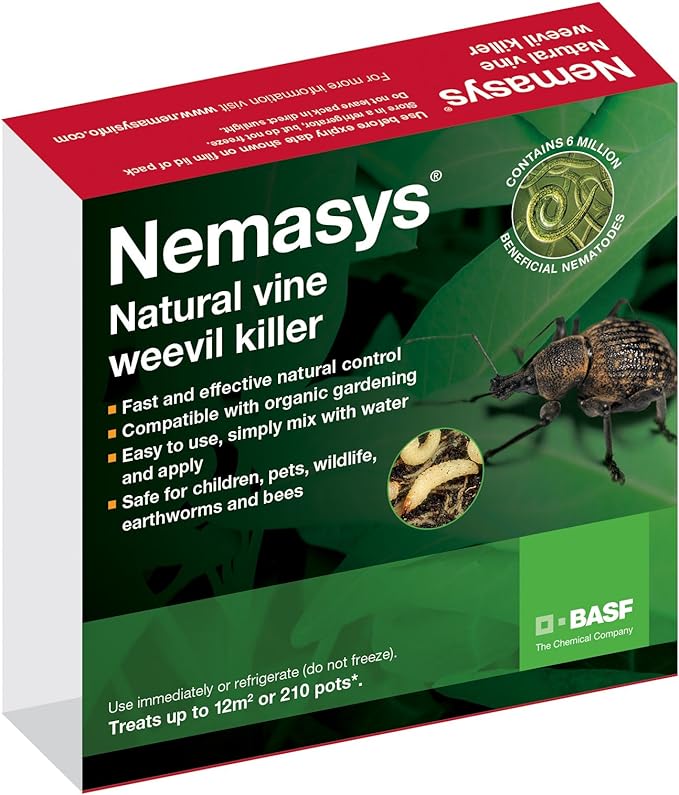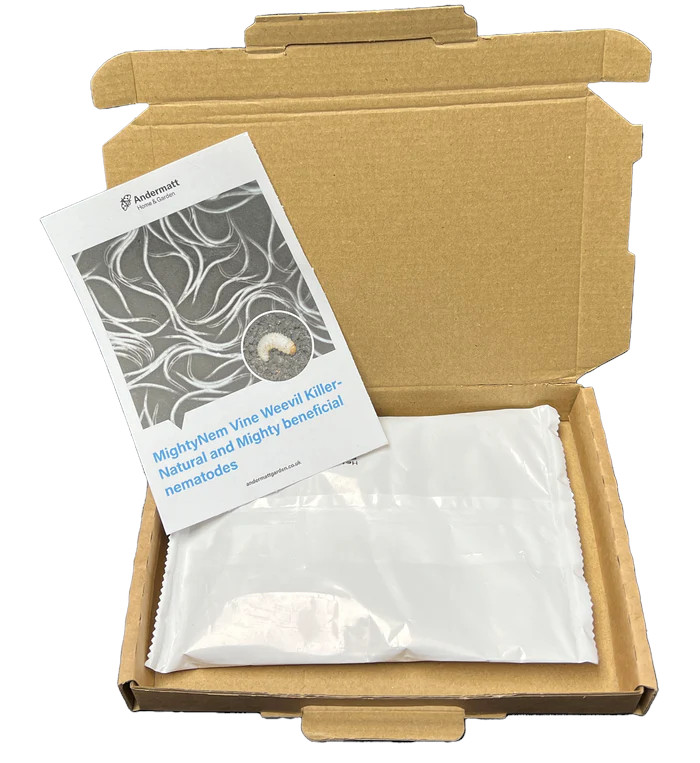Vine weevils do I need to worry?
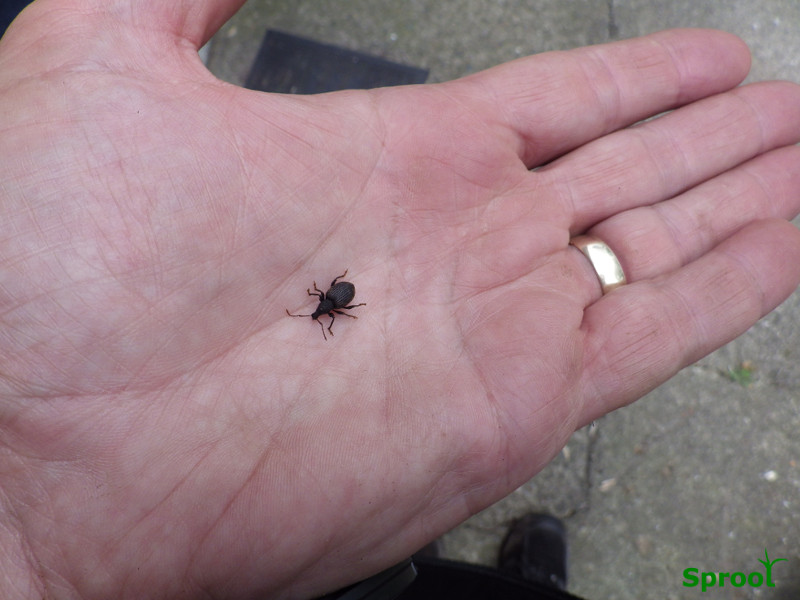
Vine weevils (also known as black vine weevils) are around 1cm in length, with long snouts and elbowed antennae.
The vine weevil is native to the UK and Europe and is established throughout the country
The adults are all female, with the ability to reproduce parthenogenetically. Females lay hundreds of eggs over extended periods and once hatched, the larvae eat the roots, tubers and lower stems of a wide range of plants.
When they have emerged the nocturnal, flightless adults continue to eat plant foliage.
Identification
Adults weevils are distinguished by their long nose and elbowed antennae. Vine weevils have a dark, matt appearance and orange tufts of hair on the wing cases. They are nocturnal creatures that don’t fly, the most obvious sign of their presence is notch shaped cuts to the leaves.
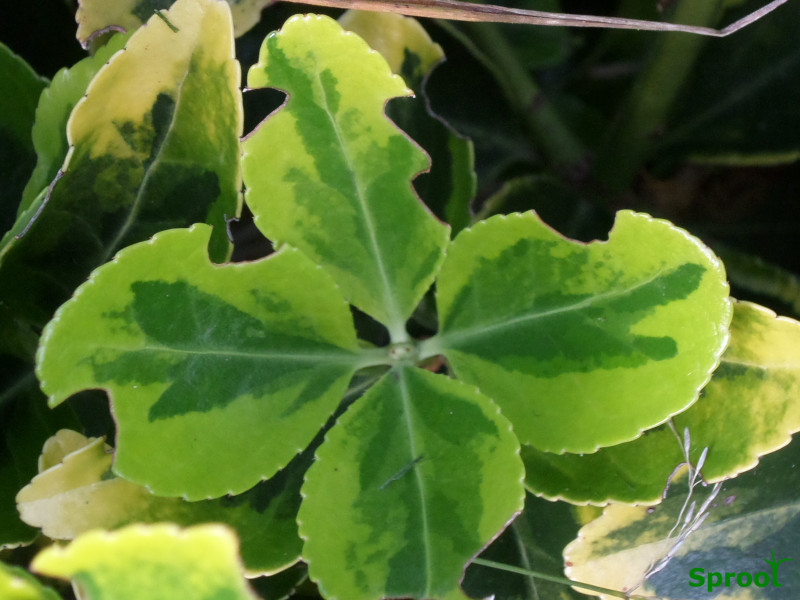
The larvae can be found in the soil close to the roots, they grow to 1.5cm, and are plump, pale and legless with hardened, brown head capsules.
There are 18 species of weevil related to the vine weevil in the UK, while they all eat leaves only the vine weevil causes significant damage to the roots.
How can you tell the difference, only the vine weevil has tiny red orange tufts on its back, more obvious on a fully grown adult.
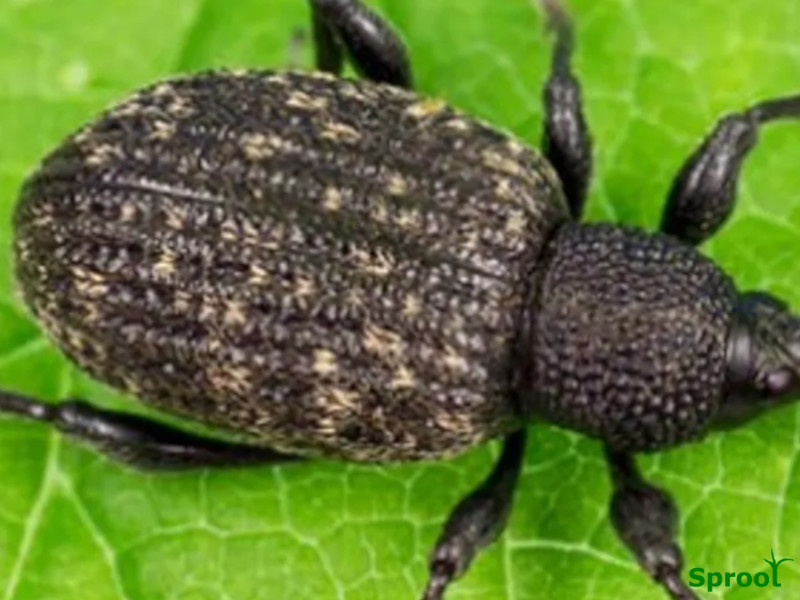
Life cycle
Female vine weevils have the ability to reproduce by a form of parthenogentic reproduction where offspring develop from unfertilised eggs, producing only females. Within these male-less populations, each female can lay several hundred eggs without the need for male fertilisation.
Eggs are laid into the soil near their favorite plants. The larvae hatch 10-15 days later and remain in the soil where they feed on roots. The larvae have six stages, growing larger with each stage and in the final phase, when they are most damaging, they can eat quite large roots.
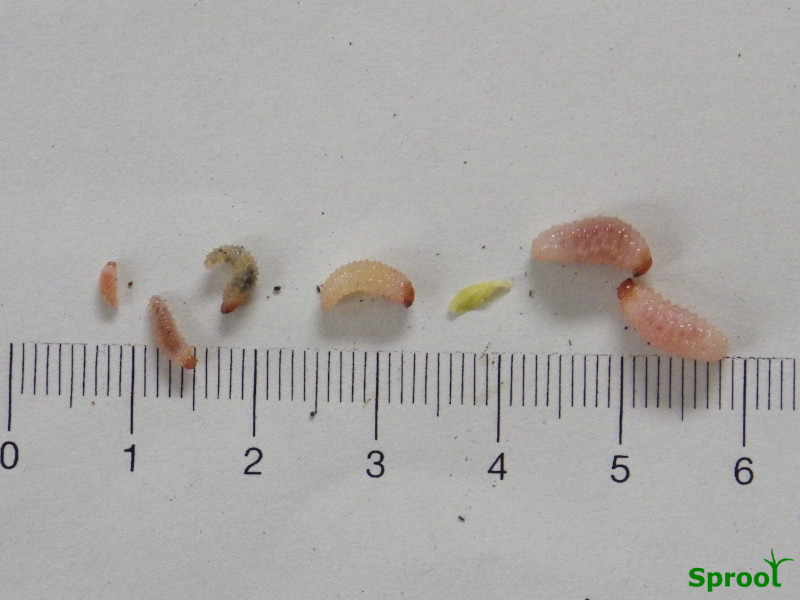
After pupating the adults are initially white, a bit alien like, becoming darker then hardening over the next 6-10 days. The adult emerges from the soil after dusk and starts feeding on the foliage, returning to the top surface layer of soil during the day.
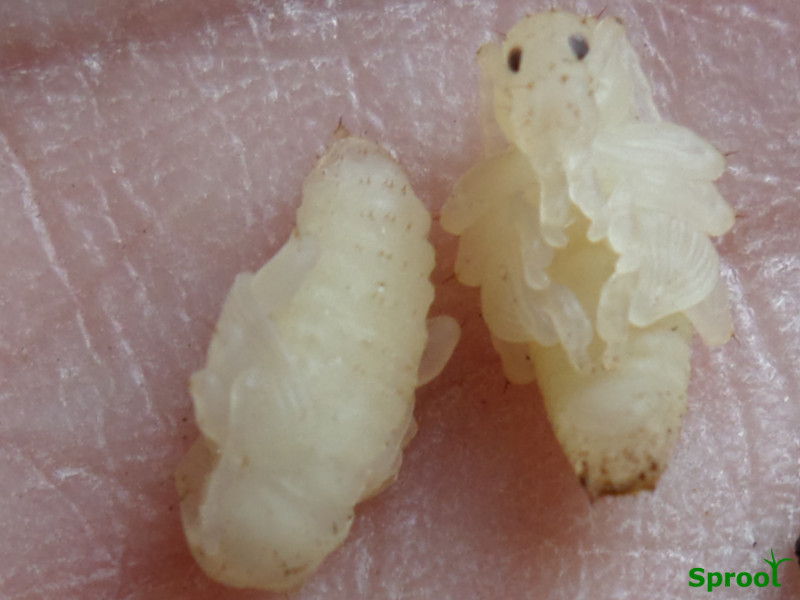
In the UK larvae are supposed to emerge May to June, however with current mild winters, they often emerge earlier, between March and April. Plants in greenhouses or indoor pot plants are under constant attack, vine weevil can emerge and lay eggs at anytime.
Damage
Vine weevil larvae attack the root systems of many garden and house plants, causing root loss, wilting and death, especially small or young plants. Adults feed on a range of plants notching the leaves but they are not as destructive as the larvae.
The wide range of food plants, the night time shenanigans of the adults and the sneaky under ground larvae mean that vine weevils can be challenging to detect and control.
Dealing with infestations
During the summer check plants for early signs of vine weevil damage, such as leaf edge notching, where adults have been feeding and more likely the unexplained wilting of plants. Check for larvae in the soil of dying plants.
Vine weevils have favourites and don’t attack all plants.
Remove and destroy any larvae or adults and dispose of soil where weevils have been found as this may contain more eggs, pupae and larvae.
The adults are often eaten by birds especially hens, in the future traps may be available for the adults.
Chemicals that worked were available, however most of the useful ones have been banned, the best way is biological control using nematodes.
Nematodes
Nematode worms are available, such as Steinernema types, and Heterorhabditis bacteriophora, they attack and destroy the larvae.
To get the best out of the nematodes you need to understand the life cycle of the weevil.
life cycle
The adult emerges from the pupa in the soil, usually in the spring or early summer, following emergence from the soil, the adult starts feeding on the edges of leaves, creating characteristic feeding notches. This period of feeding is required before eggs may develop.
Black vine weevil, have little control of its body temperature, so the temperature determines how rapidly adult development takes place, with egg laying being completed more rapidly for adults emerging in midsummer than those emerging in the spring.
Weirdly the feeding stage is reduced and the number and viability of eggs increased when they feed on leaves containing plenty of nitrogen. For example, at 24°C egg laying was 21 days when females fed on Taxus, and 50 days when feeding on Cornus.
Eggs are laid at night, either dropped to the ground while feeding, or deposited in the same hiding places where adults are found during the day, usually under the soil surface and up to a depth of 20 cm.
Once egg laying commences, the amount of feeding by the adults decreases. As long as moderate temperatures last, egg laying continues into autumn. Some adults overwinter and then emerge the following spring to recommence egg laying.
In areas with mild winters, the overwintering adult population can cause major problems because they start laying eggs very early in the year.
These overwintered adults may lay an average of 600-700 eggs during the growing season, while each adult during their first year may only lay 200-400 eggs. So although often ignored, treating or catching the over wintering adults is quite important.
Humidity and temperature interact to determine the time required for eggs to hatch, eggs can hatch in 40 days at 10°C, 20 days at 16°C, and 10 days at the optimal 25°C so in a greenhouse they can quite quickly take over.
The larval development, is also temperature dependent, 74 days under optimal conditions but up to 225 days when interrupted by a winter freeze.
How nematodes work
The nematodes enter the weevil and release symbiotic bacteria into the body cavity. These bacteria convert the larval tissue into a food source, on which nematodes feed, develop, and reproduce. The host pest dies within a few hours to days after infection. The Infected weevil turns yellow to brown but may be difficult to find, due to rapid decomposition in the compost or soil.
Nematodes are susceptible to ultraviolet light (UV): do not use them in direct sunlight.
The moisture content of the soil must be kept high for several days after application. When possible, water before and after application.
Handling
The sellers may promise you they are easy to apply and use and while this is true, it is also very easy to kill the nematodes by accident.
You can give the nematodes a fighting chance.
- Buy them from a reputable seller, check the reviews. The nematodes are alive and need to be stored correctly before they are sent out, they have a limited shelf life and the packaging should be insulated to prevent extremes of temperature.
- When they arrive check the use by date, if it is out of date or less than 4 days I would complain.
- Store the nematodes in the fridge or a cool place out of the sun.
- Try to use them as soon as possible.
- Make sure you water the pots or the ground around the plants before you apply the nematodes.
- Bright sunlight will kill the nematodes so plan to apply early in the morning or at dusk, or a dull damp day.
- Be prepared to water the nematodes in with more water.
- Follow the suppliers instructions for mixing they do vary.
- Once the nematodes are mixed you have to move fast, strangely they can drown if left too long in the water, keep the stock solution agitated.
- Apply the nematodes with plenty of water, aiming them at the base of the plants.
- Follow the dosage rates on the packet, you need to apply the correct amount.
- Nematodes work best as a preventative treatment, use the list of favourites to treat the most susceptible plants, don’t waste nematodes on plants they avoid.
Don’t waste your nematodes, vine weevils have favourites, they tend to attack the same plants every year use our checklist to make sure you protect the plants the weevils prefer.
How many do I need to buy?
5, 6, 10, 50 or 250 million ?
How will you count them all, thing is you can’t, but they are all different pack sizes, the more you buy, the bigger the area you can treat. As an example the 50 million pack will treat 100 square metres and the 6 million 12 square metres.
So work out roughly how big an area you want to cover and then choose a pack size. I would consider sharing a pack with the neighbours, bigger packs can work out cheaper per square metre.
For instance the 12 metre pack costs roughly £1.00 per metre but the 100 metre pack costs 33p per metre.
Can I buy more and store it? unfortunately not, the nematodes are alive and once the packet is opened they need to be used.
How often should I apply
Unlike chemicals which can persist in the compost for a long time, the nematodes are only active for about 4-6 weeks. If they don’t find a vine weevil host they will die. However If they manage to infect some vine weevils they will grow and multiply and quickly kill them, releasing more nematodes to infect other weevils, when they run out of weevil hosts they will die out.
Current advice suggests that little and often might be the best way to control vine weevils especially with plants in greenhouses and pots.
Prevention is better than cure, so apply regularly in the autumn, perhaps August and mid September, keeping the soil and air temperatures in mind, under 5°C and you are wasting your time, this works best for plants in the soil and pots.
In your greenhouse where vine weevils can lay all year round, I would treat the plants in the spring March or April with a follow up in the summer July or August and a final dose late September.
You can reduce the applications when you stop finding any sign of the vine weevils grubs and adults, then its worth growing some sacrificial plants, the ones they love, as an early warning system, primulas, begonias or heucheras for instance.
For vine weevils you have a choice of two types of nematodes, Steinernema types, and Heterorhabditis bacteriophora,
Steinernema types feltiae, kraussei
Soil or air temperatures below 5°C and above 35°C can be lethal – the optimum range is between 14 and 26°C – however, Steinernema feltiae & kraussei can give good results even when temperatures fluctuate between 5 to 14°C, they only need more time to work so Steinernema can be considered as a cold tolerant nematode and is the one normally sold.
they will give biological control of
Coleoptera – Weevils
Black vine weevil larvae (Otiorhynchus sulcatus)
Other weevil larvae (Otiorhynchus spp.)
but also other pests.
Diptera
Sciarids flies larvae (Lycoriella spp, Bradysia spp.)
Leafminer larvae (Liriomyza spp.)
Shore fly larvae (Scatella spp.)
Thysanoptera
Thrips pupae and larvae (Frankliniella occidentalis)
Lepidoptera – Caterpillars
Tomato leaf miner larvae (Tuta absoluta)
Noctuids larvae Armyworms (Spodoptera spp.), Cotton bollworm, Corn earworm (Helicoverpa spp.), tomato looper (Chrysodeixis chalcites), cutworms (Agrotis sp.), silver y moth (Autographa gamma).
Oak processionary moth larvae (Thaumetopoea processionea)
Common swift moth larvae (Korscheltellus lupulina)
Hemiptera
Sycamore lace bug (Corythucha ciliata)
Heterorhabditis bacteriophora, megidis
Best working conditions are during the spring, summer & autumn why does this matter?
Its not going to work outside during the winter so make sure you buy Steinernema types feltia, kraussei for treating pots and plants outside in winter.
Heterorhabditis work best with a soil or compost temperature above 12°C for at least a few hours per day , outside this is normally April to October. In the house, conservatory or greenhouse the compost temperature may be warm enough to use through the winter .
One advantage of using Heterorhabditis is the wide range of pests it can control, Heterorhabditis is widely sold as a fruit and vegetable pest killer as well as a vine weevil killer. You can treat your vine weevil and sort out a few other pests at the same time.
Soil or air temperatures below 5°C (41°F) and above 35°C (95°F) can be lethal the optimum is between 19 and 33°C (66-92°F).
For biological control of
Coleoptera – Weevil larvae
Black vine weevil (Otiorhynchus sulcatus and others species Otiorhynchus spp.)
but also other pests.
Beetles
European chafer grub (Amphimallon majale)
Common garden chafer grub (Phyllopertha horticola and Phyllophaga spp.)
Amphimallon solstitialis, Hoplia philanthus
Japanese, oriental chafer grub, and Asiatic garden beetle (Popillia japonica, Exomala orientalis, Autoserica castanea)
Dune chafer grub (Anomala dubia)
Serica brunnea, Hoplia spp. and dung beetles from the genus Aphodius spp. and young larvae of Melolontha melolontha, Amphimallon aestivus and Anoxia villosa
Chrysomelidae
Flea beetle larvae (Phyllotreta spp.)
Lepidoptera
Common swift moth larvae (Korscheltellus lupulina)

